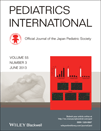Pediatric case of mesalazine-induced interstitial nephritis with literature review
Abstract
We present the case of a 14-year-old boy with ulcerative colitis who was diagnosed with mesalazine-induced interstitial nephritis (M-IIN). Improvement in renal function occurred with discontinuation of mesalazine and corticosteroid therapy. We systematically searched the literature for pediatric cases of M-IIN. There were eight cases. Majority of the cases were boys (75%) with ulcerative colitis (75%). Average duration of mesalazine use prior to the diagnosis of interstitial nephritis was 24 ± 18 months. The median dose was 1.5 g/day. M-IIN appears to be an idiosyncratic reaction without any relation to dose or duration of mesalazine use. Although there are no guidelines to recommend routine surveillance of renal function, monitoring of serum creatinine in patients on mesalazine remains an inexpensive and non-invasive test that may lead to early detection and treatment of renal injury.




